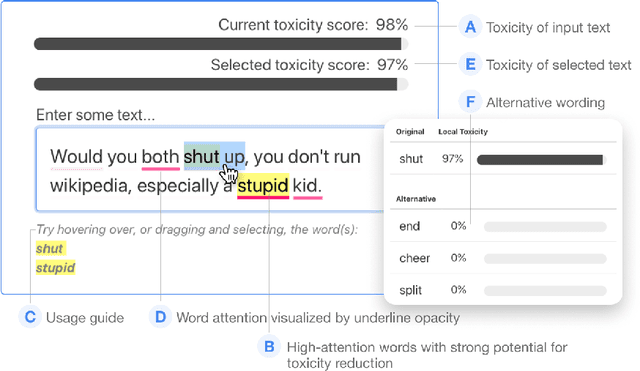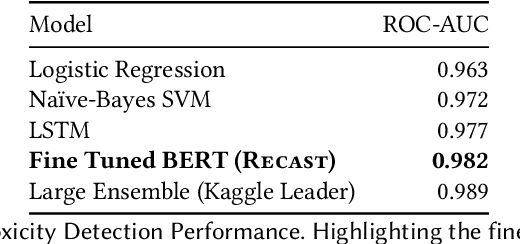Stephane Pinel
Polo
RECAST: Enabling User Recourse and Interpretability of Toxicity Detection Models with Interactive Visualization
Feb 10, 2021



Abstract:With the widespread use of toxic language online, platforms are increasingly using automated systems that leverage advances in natural language processing to automatically flag and remove toxic comments. However, most automated systems -- when detecting and moderating toxic language -- do not provide feedback to their users, let alone provide an avenue of recourse for these users to make actionable changes. We present our work, RECAST, an interactive, open-sourced web tool for visualizing these models' toxic predictions, while providing alternative suggestions for flagged toxic language. Our work also provides users with a new path of recourse when using these automated moderation tools. RECAST highlights text responsible for classifying toxicity, and allows users to interactively substitute potentially toxic phrases with neutral alternatives. We examined the effect of RECAST via two large-scale user evaluations, and found that RECAST was highly effective at helping users reduce toxicity as detected through the model. Users also gained a stronger understanding of the underlying toxicity criterion used by black-box models, enabling transparency and recourse. In addition, we found that when users focus on optimizing language for these models instead of their own judgement (which is the implied incentive and goal of deploying automated models), these models cease to be effective classifiers of toxicity compared to human annotations. This opens a discussion for how toxicity detection models work and should work, and their effect on the future of online discourse.
RECAST: Interactive Auditing of Automatic Toxicity Detection Models
Jan 07, 2020
Abstract:As toxic language becomes nearly pervasive online, there has been increasing interest in leveraging the advancements in natural language processing (NLP), from very large transformer models to automatically detecting and removing toxic comments. Despite the fairness concerns, lack of adversarial robustness, and limited prediction explainability for deep learning systems, there is currently little work for auditing these systems and understanding how they work for both developers and users. We present our ongoing work, RECAST, an interactive tool for examining toxicity detection models by visualizing explanations for predictions and providing alternative wordings for detected toxic speech.
 Add to Chrome
Add to Chrome Add to Firefox
Add to Firefox Add to Edge
Add to Edge